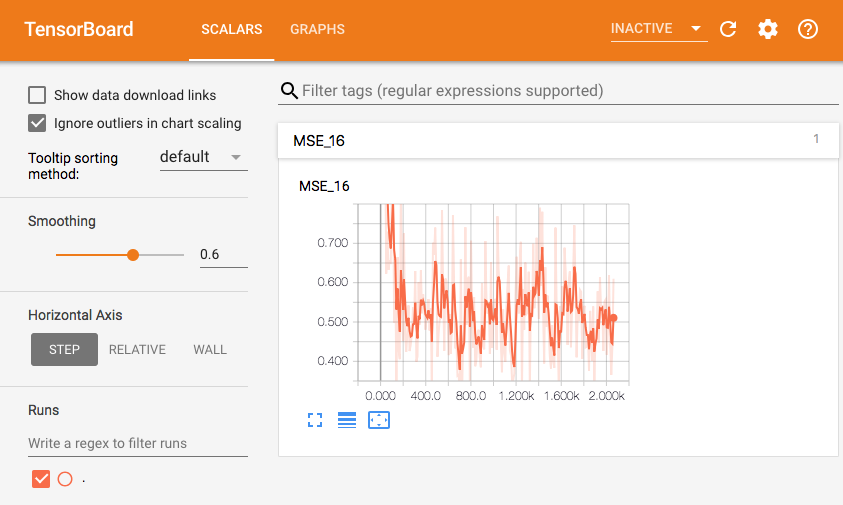はじめに
この本をGoogle Colaboratoryを使って勉強してます。
https://www.oreilly.co.jp/books/9784873118345/
「9章 TensorFlowを立ち上げる」で、TensorBoardの使い方が出てきたのですが、これもColabratory上で完結させたいなと思って調べました。
実装
今回は、本の「9.9 TensorBoardを使ったグラフと訓練曲線の可視化」 (p.240)
https://github.com/ageron/handson-ml/blob/master/09_up_and_running_with_tensorflow.ipynb
の 「Using TensorBoard」 のコードを実行できるように継ぎ接ぎしたものを使います。
import tensorflow as tf
from sklearn.datasets import fetch_california_housing
from datetime import datetime
import numpy as np
from sklearn.preprocessing import StandardScaler
housing = fetch_california_housing()
m, n = housing.data.shape
scaler = StandardScaler()
scaled_housing_data = scaler.fit_transform(housing.data)
scaled_housing_data_plus_bias = np.c_[np.ones((m, 1)), scaled_housing_data]
n_epochs = 1000
learning_rate = 0.01
X = tf.placeholder(tf.float32, shape=(None, n + 1), name="X")
y = tf.placeholder(tf.float32, shape=(None, 1), name="y")
theta = tf.Variable(tf.random_uniform([n + 1, 1], -1.0, 1.0, seed=42), name="theta")
y_pred = tf.matmul(X, theta, name="predictions")
error = y_pred - y
mse = tf.reduce_mean(tf.square(error), name="mse")
optimizer = tf.train.GradientDescentOptimizer(learning_rate=learning_rate)
training_op = optimizer.minimize(mse)
init = tf.global_variables_initializer()
now = datetime.utcnow().strftime("%Y%m%d%H%M%S")
root_logdir = "tf_logs"
logdir = "{}/run-{}/".format(root_logdir, now)
mse_summary = tf.summary.scalar('MSE', mse)
file_writer = tf.summary.FileWriter(logdir, tf.get_default_graph())
n_epochs = 10
batch_size = 100
n_batches = int(np.ceil(m / batch_size))
def fetch_batch(epoch, batch_index, batch_size):
np.random.seed(epoch * n_batches + batch_index) # not shown in the book
indices = np.random.randint(m, size=batch_size) # not shown
X_batch = scaled_housing_data_plus_bias[indices] # not shown
y_batch = housing.target.reshape(-1, 1)[indices] # not shown
return X_batch, y_batch
with tf.Session() as sess:
sess.run(init)
for epoch in range(n_epochs):
for batch_index in range(n_batches):
X_batch, y_batch = fetch_batch(epoch, batch_index, batch_size)
if batch_index % 10 == 0:
summary_str = mse_summary.eval(feed_dict={X: X_batch, y: y_batch})
step = epoch * n_batches + batch_index
file_writer.add_summary(summary_str, step)
sess.run(training_op, feed_dict={X: X_batch, y: y_batch})
best_theta = theta.eval()
file_writer.close()
best_theta
localtunnelのインストール
! npm install -g localtunnel
https://github.com/localtunnel/localtunnel
localtunnelはサーバーを適当なURLで公開するツールです。
他にも、ngrokというサービスもあります。
https://ngrok.com/
どちらでも良いと思います。
localtunnelを実行
get_ipython().system_raw(
'tensorboard --logdir {} --host 0.0.0.0 --port 6006 &'
.format(logdir)
)
get_ipython().system_raw('lt --port 6006 >> url.txt 2>&1 &')
logがあるディレクトリを指定して実行します。
URLを開く
!cat url.txt
-> your url is: https://****.localtunnel.me
結果
以上です。
URLは、Colaboratoryのインスタンスが終了したら404になります。
注意点
localtunnelを使うと、URLを知っていたら誰でも見れます。
なので、練習用途以外では使わない方が良いかなと思います。
自己責任でお試しください。
